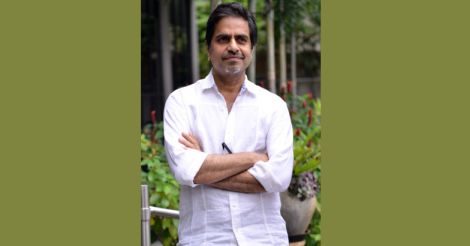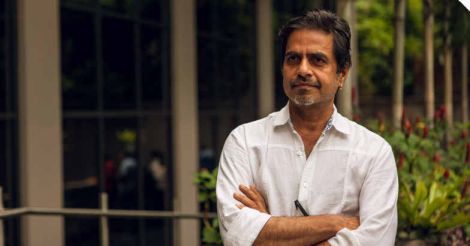A participating artist in the first Kochi-Muziris Biennale (KMB) in 2012, Sudarshan Shetty, 54, has been bestowed with the mammoth task of navigating the third edition of the Biennale next year.
Shetty, who seems pleased with shouldering the giant canvas of the KMB, which has so far drawn a million footfalls, was the unanimous choice of the jury to curate the 2016 carnival, envisioned to be a 'People's Biennale'.
The Artistic Advisory Committee for the Kochi-Muziris Biennale 2016 comprised some of the finest in the fraternity including Amar Kanwar, Atul Dodiya, Bharti Kher and Jyothi Basu, art critic and curator Ranjit Hoskote, patron Kiran Nadar and gallerist Shireen Gandhy.
“Sudarshan is a well seasoned artist who understands different disciplines,history,politics of our time and he has survived the waves of struggle along many of his contemporaries and his understanding and learning about art and the people will bring a new perspective to the Biennale,” says KMB secretary Rias Komu on the unanimous choice of Shetty as the artistic director and curator of the third edition of Kochi-Muziris Biennale.
Excerpts from an interaction Onmanorama had with the man who would be the curator of India's largest artistic jamboree in 2016 and one of the finest innovative brains in the artistic fraternity.
As a seasoned artist who shifted from the confines of painting to various mediums, including multimedia installations, how do you look at the state of Indian art scene now?
There are more artists practising today than the time when we were out of the art school. Some of the artists from my generation have been able to make a considerable mark internationally. There are certainly more opportunities for younger artists than ever before. However, we need more state-support for the scene to develop in a consolidated way. Kochi Muziris Biennale, even with its short history, has come a long way in filling that gap.

What's your idea of curating a show? How's it going to reflect in KMB-16?
I am just about beginning to work on understanding the logistics involved in bringing a show of such a scale together. Meanwhile, I am also working on a curatorial framework that could be conclusive and yet is democratic enough to include various voices from this region and across the world .
You must have already started your homework. What's the process?
I have had a few ideas to begin with, but I know for sure that it is bound to evolve into something else in the next couple of months.
Jitish Kallat had given much prominence to the history of the land where the show happens when he curated the previous edition. Do you have any such plans right now?
Yes. Taking from the mission statement of the Biennale, the location of Kochi, and its history must play a part in the conceiving of an event like this.
What was your reaction when the artistic advisory panel of KMB chose your name as the curator?
One of joy. To know their belief in me.
 Sudarshan Shetty with wife Seema and daughter Devi. Photo: Rinkuraj Mattancheriyil
Sudarshan Shetty with wife Seema and daughter Devi. Photo: Rinkuraj MattancheriyilDespite the success of the two editions of KMB, there are some including masters like Kanayi Kunhiraman who keep themselves away from the event citing various reasons, including the prominence given to market. How do you look at such dissents?
I have been an admirer of Kanayi Kunhiraman's work for a long time. I do not know if it is 'dissent'. He may have his personal reasons for it. The Biennale certainly does operate outside of the market.
You are a person who believes in the entertainment value of art, if the ability of your works to lure even an ordinary person to it are any indication. Can we expect that vision to draw more crowds to the Biennale that you are going to curate?
As it is clear from the mission statement and the last two editions of the Biennale, I gather that this a 'People's Biennale'. That spirit makes this Biennale a special one.
Your father was a Yakshagana performer. Has that fact played any part in your interest in art? Like Karanataka, your birth place, Kerala has also a rich tradition of folklores and performance arts, often ritualistic. Is it going to reflect in KMB 16 in any way?
As much as I would like to bring in the aspects of tradition and folklore, I am also aware that the question is much larger and more complex than it seems.
We will certainly look into various ways, even if obliquely, to include those positions.
If reports and what the KMB functionaries say are to be believed, the Biennale Foundation is reeling under a financial crisis. They had to struggle last time to meet the budget especially after the government stepped back from releasing the expected amount? How are you going to overcome such hurdles this time?
I am sure that there would be hurdles on various fronts, as any endeavour of this scale would have. Finances are but a part of it.
KMB functionaries believe that once a curator is appointed he is given absolute freedom to design the show. Do you believe in and expect to get such a curatorial freedom?
Yes. I believe so.
Do you have any big names in your mind for the show now? Have you started talking to artists? Will there be more space for younger and growing artists this time?
There are some names I have on my list now. It will be a few months before we can consolidate the list.
What would be different in the 2016 Kochi Biennale?
I would be happy even to match up to the standards set by my predecessors.
You made known your adoration for Adoor and John Abraham. So can we expect any experiments involving cinema as a medium?
We are still a long way before formulating a curatorial framework. Yes, experimentation by various artists will be under consideration.
What happens to your other work commitments, assuming you have already started work on the Biennale?
I have been working on a project for about six months now, which I expect to finish soon.
The Biennale has captured the imagination of many, but there is a charge that the layman is still missing from its precincts notwithstanding some curious footfalls. What needs to be done?
On the contrary, I have been to the the last two editions of the Biennale each, more than once. I have seen people from the locality and elsewhere in great numbers engaging with a lot of work .
Why can't the Biennale spread out to other spots in Kerala while keeping its Kochi-centric focus?
The scale of the Biennale with its nine locations within Kochi, as it is, is an enormous one.
















































 at a workshop by artist John Baby (left) at the art room of the Kochi-Muziris Biennale in December.jpg.image.160.84.jpg)






















.jpg.image.160.84.jpg)

.jpg.image.160.84.jpg)













































































































































 Sudarshan Shetty
Sudarshan Shetty

Disclaimer
The comments posted here/below/in the given space are not on behalf of Manorama. The person posting the comment will be in sole ownership of its responsibility. According to the central government's IT rules, obscene or offensive statement made against a person, religion, community or nation is a punishable offense, and legal action would be taken against people who indulge in such activities.